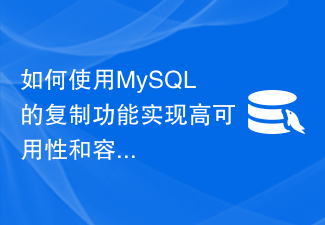 Java
Java javaTutorial
javaTutorial How to achieve fault tolerance and data reliability in distributed systems in Java
How to achieve fault tolerance and data reliability in distributed systems in Java
How to achieve fault tolerance and data reliability of distributed systems in Java?
As the scale of the Internet continues to expand, more and more systems require distributed deployment. Distributed systems have very high requirements for fault tolerance and data reliability, because in a distributed environment, an error on a single node may cause the entire system to collapse. This article will introduce how to implement fault tolerance and data reliability in distributed systems in Java and provide some specific code examples.
1. Implementation of fault tolerance
- Exception handling and retry mechanism
In a distributed system, network communication may encounter various problems , such as network disconnection, timeout, etc. In order to improve the fault tolerance of the system, we can capture these exceptions in Java code and handle them accordingly. For example, you can catch exceptions and retry until the network returns to normal or the maximum number of retries is reached.
public class DistributedSystem {
private static final int MAX_RETRY_TIMES = 3;
public void doSomething() {
int retryTimes = 0;
boolean success = false;
while (!success && retryTimes < MAX_RETRY_TIMES) {
try {
// 进行网络通信操作
// ...
success = true;
} catch (Exception e) {
retryTimes++;
// 打印异常信息
System.out.println("Exception occurred: " + e.getMessage());
// 可以添加一些容错策略,如等待一段时间再进行重试
waitSomeTime();
}
}
if (!success) {
// 处理异常,比如记录日志、发送告警等
handleException();
}
}
private void waitSomeTime() {
// 等待一段时间再进行重试
try {
Thread.sleep(1000);
} catch (InterruptedException e) {
e.printStackTrace();
}
}
private void handleException() {
// 处理异常
// ...
}
}- The circuit breaker mechanism of fault tolerance strategy
The circuit breaker mechanism is a commonly used fault tolerance strategy, which can temporarily shut down an abnormal distributed system service. Avoid chain reactions that could bring down the entire system. In Java, you can use the Hystrix library to implement the circuit breaker mechanism.
public class DistributedSystem {
private static final int TIMEOUT = 1000;
private final HystrixCommand.Setter setter;
public DistributedSystem() {
this.setter = HystrixCommand.Setter
.withGroupKey(HystrixCommandGroupKey.Factory.asKey("Group"))
.andCommandPropertiesDefaults(HystrixCommandProperties.Setter()
.withExecutionTimeoutInMilliseconds(TIMEOUT));
}
public void doSomething() {
HystrixCommand<String> command = new HystrixCommand<String>(setter) {
@Override
protected String run() throws Exception {
// 进行网络通信操作
// ...
return "success";
}
@Override
protected String getFallback() {
// 进行熔断后的处理逻辑
// ...
return "fallback";
}
};
String result = command.execute();
System.out.println("Result: " + result);
}
}2. Implementation of data reliability
- Data backup and recovery
In a distributed system, in order to ensure the reliability of data, it is necessary to Back up data so that it can be restored in the event of node failure. In Java, data backup and recovery can be achieved using distributed cache or distributed storage systems such as Redis.
public class DistributedSystem {
private static final String REDIS_HOST = "localhost";
private static final int REDIS_PORT = 6379;
private static final String KEY = "data_key";
public void backupData(String data) {
Jedis jedis = null;
try {
jedis = new Jedis(REDIS_HOST, REDIS_PORT);
jedis.set(KEY, data);
System.out.println("Data backup success");
} finally {
if (jedis != null) {
jedis.close();
}
}
}
public String recoverData() {
Jedis jedis = null;
try {
jedis = new Jedis(REDIS_HOST, REDIS_PORT);
String data = jedis.get(KEY);
System.out.println("Data recovery success");
return data;
} finally {
if (jedis != null) {
jedis.close();
}
}
}
}- Data consistency based on distributed transactions
In a distributed system, operations between multiple nodes may involve multiple data items. In order to ensure Data consistency requires the use of distributed transactions. In Java, distributed transactions can be implemented using frameworks such as JTA (Java Transaction API).
public class DistributedSystem {
private static final String JDBC_URL = "jdbc:mysql://localhost:3306/database";
private static final String JDBC_USER = "root";
private static final String JDBC_PASSWORD = "password";
public void transferAmount(String from, String to, double amount) {
try {
// 获取数据源
DataSource dataSource = getDataSource();
// 开启分布式事务
UserTransaction userTransaction = getUserTransaction();
userTransaction.begin();
// 执行分布式事务操作
Connection connection = dataSource.getConnection();
try {
// 更新账户余额
updateAccountBalance(connection, from, -amount);
updateAccountBalance(connection, to, amount);
// 提交分布式事务
userTransaction.commit();
System.out.println("Transfer amount success");
} catch (Exception e) {
// 回滚分布式事务
userTransaction.rollback();
System.out.println("Transfer amount failed");
} finally {
connection.close();
}
} catch (Exception e) {
e.printStackTrace();
}
}
private DataSource getDataSource() {
// 创建数据源
MysqlDataSource dataSource = new MysqlDataSource();
dataSource.setURL(JDBC_URL);
dataSource.setUser(JDBC_USER);
dataSource.setPassword(JDBC_PASSWORD);
return dataSource;
}
private UserTransaction getUserTransaction() throws NamingException {
// 获取UserTransaction
InitialContext context = new InitialContext();
return (UserTransaction) context.lookup("java:comp/UserTransaction");
}
private void updateAccountBalance(Connection connection, String account, double amount) throws SQLException {
// 更新账户余额
String sql = "UPDATE account SET balance = balance + ? WHERE account_no = ?";
try (PreparedStatement statement = connection.prepareStatement(sql)) {
statement.setDouble(1, amount);
statement.setString(2, account);
statement.executeUpdate();
}
}
}The above are some sample codes on how to achieve fault tolerance and data reliability of distributed systems in Java. The fault tolerance and data reliability of distributed systems are very complex issues that need to be designed and implemented based on specific scenarios and requirements. I hope the content of this article can be helpful to you.
The above is the detailed content of How to achieve fault tolerance and data reliability in distributed systems in Java. For more information, please follow other related articles on the PHP Chinese website!
 如何在Java中实现高可用性和容错性Oct 08, 2023 pm 12:30 PM
如何在Java中实现高可用性和容错性Oct 08, 2023 pm 12:30 PM如何在Java中实现高可用性和容错性在现如今的互联网和大数据时代,高可用性和容错性是任何系统的必备特性。尤其是对于使用Java开发的系统而言,如何实现高可用性和容错性显得尤为重要。本文将讨论在Java中如何实现高可用性和容错性,并提供一些具体的代码示例。层级化的架构设计实现高可用性和容错性的第一步是采用层级化的架构设计。这意味着将系统划分为多个模块或服务,并
 如何使用MySQL的复制功能实现高可用性和容错性?Sep 08, 2023 am 09:10 AM
如何使用MySQL的复制功能实现高可用性和容错性?Sep 08, 2023 am 09:10 AM如何使用MySQL的复制功能实现高可用性和容错性?随着互联网的快速发展,数据库的高可用性和容错性变得越来越重要。MySQL是一种广泛使用的开源关系型数据库,它的复制功能可以帮助我们实现数据库的高可用性和容错性。在本文中,我们将介绍如何使用MySQL的复制功能来实现数据库的高可用性和容错性。一、什么是MySQL的复制功能?MySQL的复制是一种将一台MySQL
 如何在Java中实现分布式系统的容错性和数据可靠性Oct 09, 2023 am 08:49 AM
如何在Java中实现分布式系统的容错性和数据可靠性Oct 09, 2023 am 08:49 AM如何在Java中实现分布式系统的容错性和数据可靠性?随着互联网规模的不断扩大,越来越多的系统需要进行分布式部署。分布式系统对于容错性和数据可靠性的要求非常高,因为在分布式环境下,单个节点的错误可能导致整个系统的崩溃。本文将介绍如何在Java中实现分布式系统的容错性和数据可靠性,并提供一些具体的代码示例。一、容错性的实现异常处理和重试机制在分布式系统中,网络通
 Nginx服务器的高可用性和容错性设计原则详解Aug 26, 2023 pm 07:31 PM
Nginx服务器的高可用性和容错性设计原则详解Aug 26, 2023 pm 07:31 PMNginx服务器的高可用性和容错性设计原则详解随着计算机系统的复杂性增加和对高可用性和容错性的需求日益提高,设计一个稳定可靠的服务器变得尤为重要。Nginx是一个高性能的开源Web服务器,同时也是一个反向代理服务器、负载均衡器和HTTP缓存服务器。Nginx的设计原则和功能使其具备了优秀的高可用性和容错性。本文将详细介绍Nginx服务器的高可用性和容错性设计
 Go语言在云计算中如何支持容错性?May 16, 2023 pm 07:22 PM
Go语言在云计算中如何支持容错性?May 16, 2023 pm 07:22 PM随着云计算的发展,容错性已经成为了一个至关重要的问题,因为在大规模的云环境中,任何的故障和错误可能会导致系统的崩溃,影响到用户的体验和服务的可用性。因此,在这个领域中,人们一直在寻找各种方法和技术来提高系统的容错性。而在这些技术中,Go语言也逐渐成为了一种流行的选择。首先,让我们看一下什么是容错性。容错性是指即使系统中发生了某些故障或错误,系统仍然能够继续运
 了解MySQL和PostgreSQL的高可用性和容错性Jul 13, 2023 pm 01:30 PM
了解MySQL和PostgreSQL的高可用性和容错性Jul 13, 2023 pm 01:30 PM了解MySQL和PostgreSQL的高可用性和容错性摘要:本文将介绍MySQL和PostgreSQL两种关系型数据库管理系统的高可用性和容错性,包括主从复制、多主复制、自动故障转移等功能,并提供相关代码示例。一、MySQL的高可用性和容错性实现方法主从复制(Master-SlaveReplication)主从复制是MySQL中常用的实现高可用性和容错性的
 Java 中的分布式系统监控和调优技术Jun 09, 2023 am 08:14 AM
Java 中的分布式系统监控和调优技术Jun 09, 2023 am 08:14 AM随着互联网的迅猛发展,越来越多的企业开始使用分布式系统来构建大规模应用,而Java是目前最常用的语言之一。分布式系统需要面临的问题包括网络延迟、不可靠的通信、节点故障等,这些都会对系统的性能和可靠性造成挑战。为了满足高可用性和高性能的要求,分布式系统监控和调优技术变得至关重要。本文将介绍Java中的分布式系统监控和调优技术,包括以下方面:1.监控基础对于任何
 如何在MySQL中设计一个高可用的会计系统表结构以确保数据的可靠性和可用性?Oct 31, 2023 am 08:06 AM
如何在MySQL中设计一个高可用的会计系统表结构以确保数据的可靠性和可用性?Oct 31, 2023 am 08:06 AM如何在MySQL中设计一个高可用的会计系统表结构以确保数据的可靠性和可用性?在设计一个高可用的会计系统表结构时,我们需要考虑数据的可靠性和可用性。下面将介绍一些在MySQL中设计高可用的会计系统表结构的方法,并提供相应的代码示例。使用事务事务是确保数据的一致性和可靠性的重要工具。在会计系统中,各种账户、凭证和交易等数据都需要保证完整性和一致性。通过使用事务,


Hot AI Tools

Undresser.AI Undress
AI-powered app for creating realistic nude photos

AI Clothes Remover
Online AI tool for removing clothes from photos.

Undress AI Tool
Undress images for free

Clothoff.io
AI clothes remover

AI Hentai Generator
Generate AI Hentai for free.

Hot Article

Hot Tools

PhpStorm Mac version
The latest (2018.2.1) professional PHP integrated development tool

DVWA
Damn Vulnerable Web App (DVWA) is a PHP/MySQL web application that is very vulnerable. Its main goals are to be an aid for security professionals to test their skills and tools in a legal environment, to help web developers better understand the process of securing web applications, and to help teachers/students teach/learn in a classroom environment Web application security. The goal of DVWA is to practice some of the most common web vulnerabilities through a simple and straightforward interface, with varying degrees of difficulty. Please note that this software

SecLists
SecLists is the ultimate security tester's companion. It is a collection of various types of lists that are frequently used during security assessments, all in one place. SecLists helps make security testing more efficient and productive by conveniently providing all the lists a security tester might need. List types include usernames, passwords, URLs, fuzzing payloads, sensitive data patterns, web shells, and more. The tester can simply pull this repository onto a new test machine and he will have access to every type of list he needs.

Safe Exam Browser
Safe Exam Browser is a secure browser environment for taking online exams securely. This software turns any computer into a secure workstation. It controls access to any utility and prevents students from using unauthorized resources.

MinGW - Minimalist GNU for Windows
This project is in the process of being migrated to osdn.net/projects/mingw, you can continue to follow us there. MinGW: A native Windows port of the GNU Compiler Collection (GCC), freely distributable import libraries and header files for building native Windows applications; includes extensions to the MSVC runtime to support C99 functionality. All MinGW software can run on 64-bit Windows platforms.





